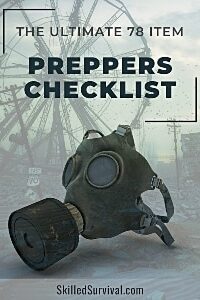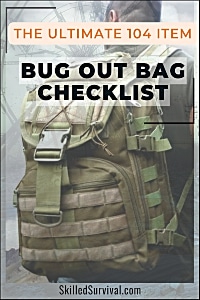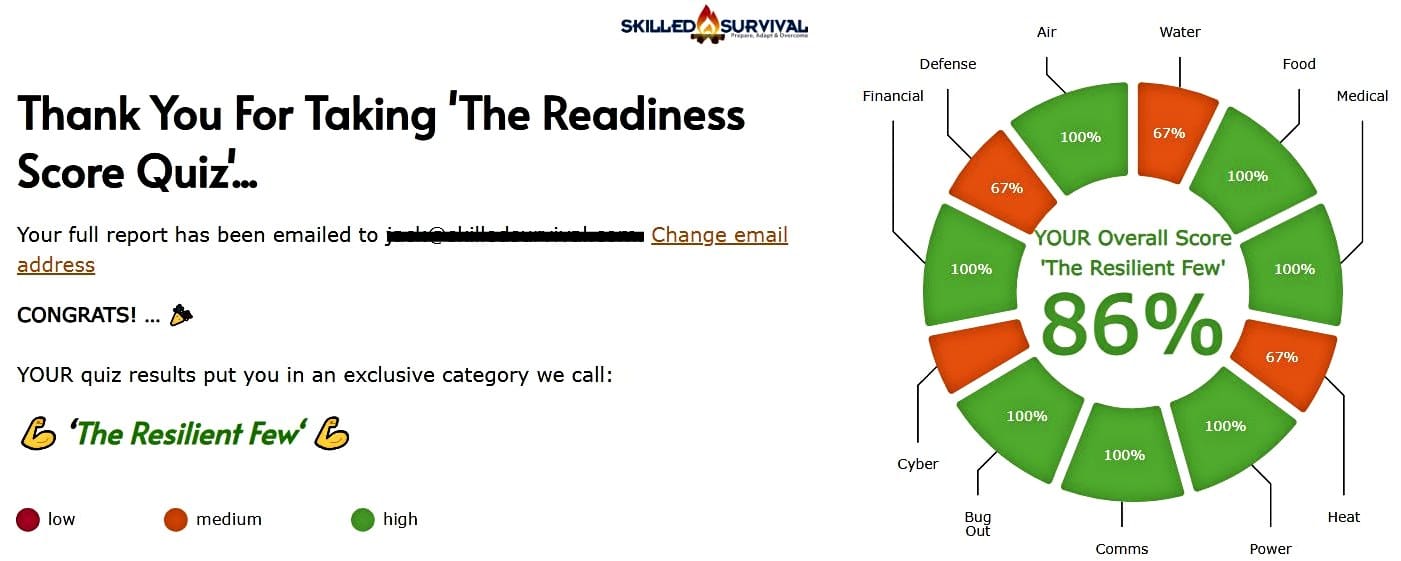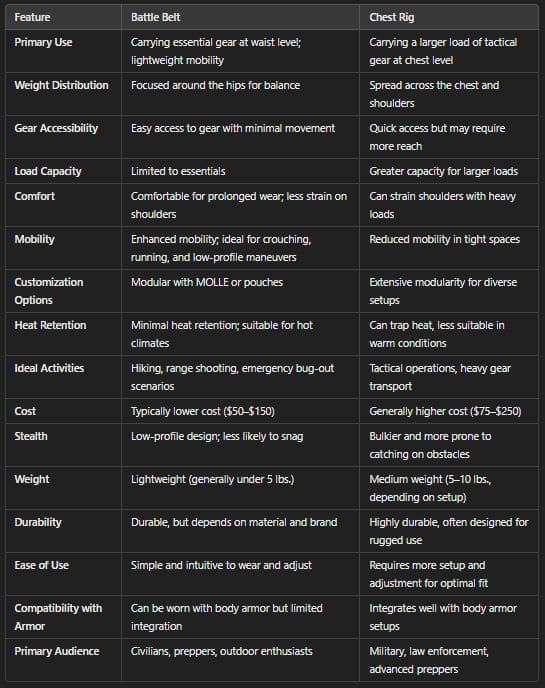
Each system has strengths and weaknesses; the best choice depends on your mission, environment, and personal preferences.
In this deep dive, we’ll unpack the pros and cons of both options, examining them from every angle—comfort, utility, accessibility, modularity, and even historical usage.
By the end, you’ll have the knowledge to decide which fits your needs best or if a combination is the ultimate solution.

Want a free 78 item preppers checklist?
Enter your email below to instantly download this Complete Checklist PDF. No purchase necessary. 👇 👇What Are Battle Belts and Chest Rigs?
Before diving into the comparison, let’s define what we’re talking about.
Battle Belt
A battle belt, sometimes called a war belt or load-bearing belt, is a heavy-duty belt designed to carry essential gear like holsters, mag pouches, med kits, and other accessories.
These belts are built for durability, modularity, and ease of access. They’re a core piece of equipment for military, law enforcement, and preparedness enthusiasts alike.
Chest Rig
A chest rig is a lightweight harness worn on the torso, equipped with pouches and compartments to hold gear.
Originally designed for carrying ammunition, modern chest rigs have evolved to accommodate radios, medical supplies, survival tools, and more.
They’re popular among preppers, outdoorsmen, and tactical operators who need high-capacity, chest-level storage.
Now that we know what they are, let’s break down the key aspects of each.
Accessibility: The Gear You Need, When You Need It
Battle Belt
Accessibility is a standout feature of the battle belt.
Gear is carried around the waist, making it quick and easy to grab essential items like extra mags, a sidearm, or a first-aid kit.
Your hands naturally fall to your waist, so retrieving items from a battle belt is almost instinctive.
However, accessibility can depend on how much gear you’re carrying.
Overloading a battle belt can make it cumbersome, slowing down your ability to retrieve items.
It’s crucial to strike a balance between carrying essential gear and maintaining ease of use.
Chest Rig
Chest rigs also provide solid accessibility but in a different way.
Gear is positioned on your chest, making it easy to see what you’re grabbing—especially in low-light situations.
This visual accessibility can be a game-changer in high-stress environments.
That said, reaching items on your chest can be slower and less intuitive than on a battle belt.
The more loaded your rig, the harder it may be to quickly access gear in tight quarters or when prone.
Winner: Tie. Battle belts excel in natural accessibility, while chest rigs shine in visibility and organization.

Want a free 104 item bug out bag checklist?
Enter your email below to instantly download this Complete Checklist PDF. No purchase necessary. 👇 👇Comfort: Staying Mobile for the Long Haul
Battle Belt
Battle belts are designed to distribute weight around your hips, which is generally more ergonomic for extended wear.
If adjusted properly, they’re less likely to cause fatigue or strain.
However, adding too much weight can lead to discomfort, especially if the belt shifts during movement.
One downside is compatibility with tactical backpacks.
A heavy-duty pack can interfere with a battle belt, causing pinching or restricting movement.
It’s worth considering if your setup involves carrying a rucksack for extended periods.
Chest Rig
Chest rigs, on the other hand, keep your waist free, which is a significant advantage when paired with a heavy backpack.
The weight is distributed across your shoulders and chest, making it easier to carry additional loads on your back.
However, long-term wear can lead to shoulder fatigue, especially with a heavily loaded rig.
Ventilation is another concern; chest rigs can trap heat and cause sweating, which can be uncomfortable in hot climates.
Winner: Depends on your loadout and mission.
For heavy backpacking, a chest rig wins.
For extended wear without a pack, the battle belt takes the lead.
Modularity: Building a System That Works for You
Battle Belt
Modularity is where battle belts shine.
They’re designed to work with MOLLE (Modular Lightweight Load-carrying Equipment) systems, allowing you to attach various pouches, holsters, and accessories. This versatility lets you customize your setup to suit your mission.
You can also pair a battle belt with suspenders or a harness for added stability.
This flexibility makes it a favorite for those who want a minimalist setup that can expand as needed.
Chest Rig
Chest rigs are equally modular but in a different way.
Many chest rigs come with built-in pouches and compartments, which can simplify your loadout.
They’re also MOLLE-compatible, so you can add or rearrange gear to fit your needs.
One advantage of chest rigs is their ability to integrate with plate carriers.
This combination provides both storage and ballistic protection, making it a go-to choice for tactical operators and serious preppers.
Winner:
Tie. Both systems are highly modular, offering endless customization options.
Load Capacity: How Much Can You Carry?
Battle Belt
Battle belts are designed for lighter, more essential loadouts.
They’re perfect for carrying sidearms, spare mags, a med kit, and a few tools.
However, they’re not ideal for carrying larger or bulkier items.
If you try to overload a battle belt, you’ll quickly feel the strain.
Excessive weight can cause the belt to shift or sag, impacting comfort and mobility.
Chest Rig
Chest rigs have a higher load capacity compared to battle belts.
They’re built to carry multiple mags, radios, survival gear, and more.
If your mission requires a heavy loadout, a chest rig will likely serve you better.
That said, a heavily loaded chest rig can become unwieldy and tiring to wear.
Balance is key—overloading your rig can compromise both comfort and accessibility.
Winner:
Chest rig. Its higher capacity makes it the better choice for gear-intensive missions.
Mobility: Moving Through the Field
Battle Belt
One of the biggest advantages of a battle belt is its low-profile design.
It doesn’t restrict your upper body, allowing for full range of motion.
Whether climbing, running, or crawling, a battle belt won’t get in your way.
However, it’s worth noting that a poorly fitted belt can cause issues. If it’s too loose, it may shift during movement.
If it’s too tight, it can dig into your hips.
Chest Rig
Chest rigs can restrict mobility, especially if they’re overloaded. Crawling or going prone can be uncomfortable, and the bulk on your chest may get in the way when maneuvering through tight spaces.
That said, chest rigs excel in environments where staying upright is key, such as urban settings or dense forests.
Winner: Battle belt. Its low-profile design offers superior mobility.
Durability: Built to Last
Battle Belt
Battle belts are made to withstand heavy use and harsh conditions.
They’re typically constructed from durable materials like nylon and reinforced stitching, ensuring they hold up over time.
Chest Rig
Chest rigs are equally durable, designed to endure rugged environments and frequent use.
Like battle belts, they’re often made from high-quality materials and feature reinforced seams.
Winner:
Tie. Both systems are built for durability.
Historical Context: Lessons From the Past
Battle belts and chest rigs both have deep roots in military history.
Battle Belts
These devices trace back to the load-bearing equipment used by soldiers in World War I and II.
These early designs were simple but effective, allowing soldiers to carry essential gear within arm’s reach.
Chest Rigs
Chest rigs gained prominence during the Vietnam War, where they were favored by Viet Cong fighters for their ability to carry ample ammunition and supplies.
The design has since evolved, becoming a staple for modern tactical operations.
Winner:
Tie. Both systems have proven their worth on the battlefield.

Want a free 78 item prepper checklist?
Enter your email below to instantly download this Complete Checklist PDF. No purchase necessary. 👇 👇Battle Belt Vs Chest Rig Comparision Chart
Recommendations:
- Choose a Battle Belt if you value mobility, lightweight gear, and simplicity. It’s an excellent option for hiking, short missions, or when paired with a backpack.
- Opt for a Chest Rig if you need to carry extensive tactical equipment, require more storage, or plan to integrate it with body armor.
The Bottom Line: Battle Belt vs. Chest Rig
There’s no one-size-fits-all answer when deciding between a battle belt and a chest rig.
Each system has strengths and weaknesses; the best choice depends on your needs.
- Choose a Battle Belt if: You prioritize mobility, ease of access, and a lightweight setup. It’s ideal for minimalist load-outs and environments where speed and agility are key.
- Choose a Chest Rig if: You need to carry a larger loadout, work in conjunction with a backpack, or operate in environments where staying upright is essential.
- Or Combine Both: For maximum versatility, consider using both systems together. A battle belt can carry essential gear, while a chest rig handles bulkier items. This combo provides the best of both worlds.
Ultimately, the decision comes down to your mission, environment, and personal preferences.
Whether you’re prepping for survival, training tactically, or gearing up for an outdoor adventure, understanding the strengths and weaknesses of battle belts and chest rigs will ensure you’re ready for whatever comes your way.
Why Trust Skilled Survival...
Go here now to review a full breakdown of:
- Who We Are
- Our Credentials
- Our Mission
- & Product Recommendations...
Here are a few highlights of our teams credentials & certifications:
- Certified Member of a Mountain Search & Rescue Organization
- Plant Emergency & Safety Leader for a Major Food Manufacturer
- Member of the 10TH Mountain Division Hut Association
- Certifications: Avalanche 1, WFR, CPR
- Official Gear Tester for Numerous Outdoor Gear Companies
- Countless Multiday Backpacking trips into Remote Wilderness
- Bachelor's Degree In Mechanical Engineering
- Bachelor's Degree In Civil Engineering
- Bachelor's Degree In Biomedical Engineering
"It takes 20 years to build a reputation and five minutes to ruin it." - Warren Buffett
We're fully aware that trust is NOT something you GET but is EARNED.
And we'll continue to earn YOUR trust through our forthright and honest approach with each new Blog Post, Guide & Product we create...
Prepare, Adapt & Overcome,


AND... I've still got a few gaps in my preps...🤔 But at least, I'm not part of 'The Fragile Masses'. 👍 Find out where YOU stand by answering a few questions...

